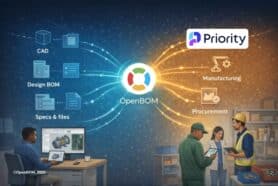
The engineering design and manufacturing process are complex and multi-faceted systems that have many moving parts. For decades CAD systems were storing data in files and that was okay. PDM systems were invented to manage those files, but things didn’t get better. A gigantic amount of inefficient processes live in these file-based systems which put a burden on the overall process, and the number of time companies are spending on data handover and different file orchestration. In this blog post, we will take a look at some of the common causes of manufacturing process inefficiency and how CAD files can contribute to them. We will also discuss some potential solutions that can help improve workflow efficiency.
A Story Of File To Data Translation
I will tell you a story of information flow I learned about a few days ago with one of our customers. I will omit the name of the company and some other personal details. What is important is understanding their business process management, existing processes, and the file-based technology used to make it work.
The customer works with a very sophisticated CAD system for their design. Their goal to make a BOM is not a simple task. However, they have an even bigger goal – to make a really useful BOM that includes images, files, and additional attributes all packaged together, so they will be able to bring this information to their contract manufacturer and production facilities.
Here is the process I discovered with the customer. An engineer creates an output of STEP files from their existing CAD system, then imports it to another CAD system (now completely cloud-based), fix some inconsistencies caused by a manual export and import of STEP files, then use OpenBOM service to generate BOM and place it to PDF format.
Imagine the number of file imports/exports, translations, and manual work needed to make it work. It is just crazy and I was amazed by how engineers pull off all these processes. Let’s talk about why it keeps happening.
Files and Bad Habits Die Hard
File-based information management paradigm was born 50-60 years ago and since then has practically remained unchanged. Everyone knows and is familiar with files, it is something that was useful for years, simple to understand, and seems relatively easy to manage. Until it was not…
Engineers for years were working with CAD systems and different export/import/translation utilities. Save as a format A, import, translate to format B, change, and export to format D. In between send these files via email or place them on network drives.
The main engineering motive to manage them in such a way is a fundamental desire of engineers to be independent and pull resources to do so. Why talk to IT and develop some process improvements, while I (the engineer) was always making the import, the export, then import again?
Asking engineers why they do so made me think about how fragile the entire data-driven process is, how many mistakes can be introduced in this way and how engineering time and energy are usually spent on all file-based data handover and translation.
Digital Transformation, Online Services, and Streamline Data Flow
The world is changing and fast-moving to online connected experience. 20 years ago, people were asking how to save the data in a specific format to send it to someone as an email attachment. Nowadays, a new generation of people is only asking 2 questions – how to get the app or what URL to navigate to do some work.
Connected systems can make a difference in organizing information flow and data exchange by streamlining the experience. Both desktop and cloud systems can seamlessly connect to each other and perform data export, which can be on-demand, scheduled, or event-driven.
OpenBOM can be a great help to all these companies struggling to organize digital and connected information flow. OpenBOM provides a set of integrated services that automate data extraction by collecting product structure, attributes, and files, performing file translation in needed formats (eg. PDF, DXF, etc), and making it all available for other people inside the organization or outside.
What if there is no out-of-the-box integration with OpenBOM? We have a solution for such a situation as well. OpenBOM REST API and CAD integration toolkit provide a set of tools that allows you to develop integration with any system.
Conclusion
Old file-based habits are painful and can slow down any organization. Almost every person who ever worked with manufacturing businesses and process improvement knows how hard to get these file-based processes out and switched into a better digital experience. At OpenBOM we save tens of hours every week for engineers working with CAD environments that then use OpenBOM to streamline data handover and operations.
REGISTER FOR FREE and start a 14-day trial to check how OpenBOM can help you today.
Best, Oleg
Join our newsletter to receive a weekly portion of news, articles, and tips about OpenBOM and our community.










